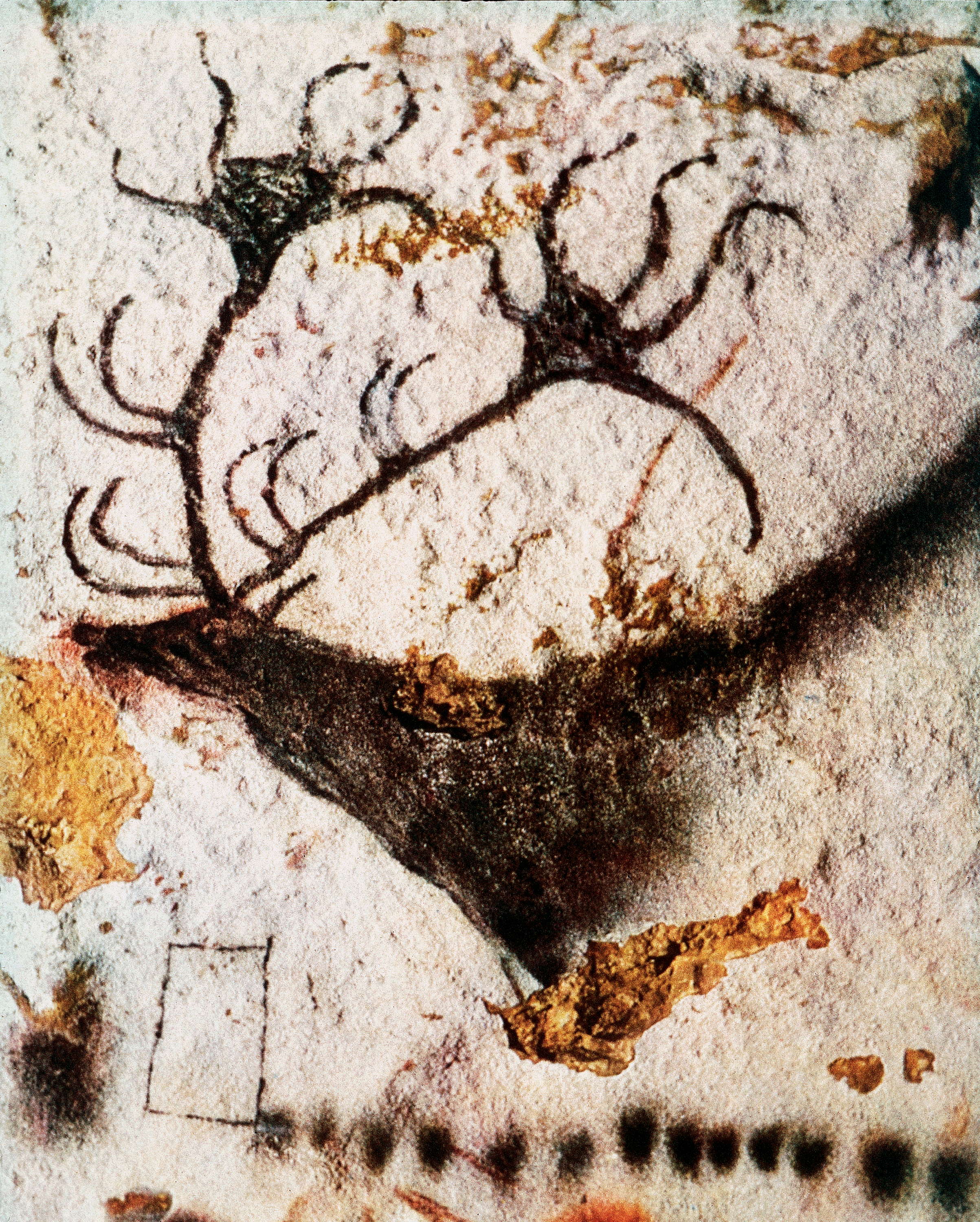
+- WildFact (https://wildfact.com/forum)
+-- Forum: Information Section (https://wildfact.com/forum/forum-information-section)
+--- Forum: Extinct Animals (https://wildfact.com/forum/forum-extinct-animals)
+---- Forum: Prehistoric animals (https://wildfact.com/forum/forum-prehistoric-animals)
+---- Thread: Pleistocene Cave Art (/topic-pleistocene-cave-art)
Pleistocene Cave Art - KRA123 - 10-13-2020
This is a thread for the appreciation, analysis and discussion of Pleistocene cave art from around the world. Cave art, also called parietal art, includes cave paintings, as well as all forms of engraved rock art, other petroglyphs, and any relief sculpture carved on walls, floors or ceilings. Since this is an animal forum, it's probably best to stick to cave art that represents animals, living or extinct.
For the inaugural post, here is an image of the famous Black Stag painting from the walls of the Lascaux Cave in France. The photo is from Don's Maps

*This image is copyright of its original author
It is often thought to be a depiction of the well-known extinct deer Megaloceros giganteus, aka the Irish Elk, but I think it is clearly a representation of a far more familiar animal - the fallow deer! I did a full write up of the reasoning which led me to this conclusion, and you can find that here. I think it's a little strange that fallow deer were given such an imposing portrayal in the cave, but there are large paintings of other medium sized animals in the Lascaux caves - in particular, of horses.
If this painting is really of a fallow deer, which I think it really seems to be, then that means means there is one less "Megaloceros" depiction to refer to when trying to reconstruct that animal, but the ones in Cosquer and Chauvet are still there, and I think the Black Stag painting was a bit at-odds with these other depictions anyways.
RE: Pleistocene Cave Art - BorneanTiger - 10-19-2020
Shifted from the thread "The Evolution of Man":
Spain (the country of Pablo Picasso) has the oldest known works of art in the World (cave-art to be more precise), dating back to the age of our long-lost cousins, the Neanderthals (Homo neanderthalensis or Homo sapiens neanderthalensis), at about 65,000 years ago: https://www.nationalgeographic.com/news/2018/02/neanderthals-cave-art-humans-evolution-science/
In a cave in Spain, scientists found this ladder shape made of red horizontal and vertical lines. The artwork dates to more than 64,000 years ago, suggesting that it was created by Neanderthals. Photograph by P. Saura:
[attachment=4448]
A closer view of the red ladder shape, painted on the wall of a cave in Spain. Photograph by C. D. Standish, A. W. G. Pike and D. L. Hoffmann:
[attachment=4449]
A drawing of the art shows animals and other symbols around the ladder shape. It's still unclear if they date to the same time, or were painted later. Photograph by Breuil et al.:
[attachment=4450]
A hand stencil on another cave wall in Spain has been dated to at least 66,000 years ago, strongly suggesting that it was left by a Neanderthal. Photograph by H. Collado:
[attachment=4451]
RE: Pleistocene Cave Art - Balam - 12-06-2020
Abstract
Recent research carried out in the Serranía La Lindosa (Department of Guaviare) provides archaeological evidence of the colonisation of the northwest Colombian Amazon during the Late Pleistocene. Preliminary excavations were conducted at Cerro Azul, Limoncillos and Cerro Montoya archaeological sites in Guaviare Department, Colombia. Contemporary dates at the three separate rock shelters establish initial colonisation of the region between ~12,600 and ~11,800 cal BP. The contexts also yielded thousands of remains of fauna, flora, lithic artefacts and mineral pigments, associated with extensive and spectacular rock pictographs that adorn the rock shelter walls. This article presents the first data from the region, dating the timing of colonisation, describing subsistence strategies, and examines human adaptation to these transitioning landscapes. The results increase our understanding of the global expansion of human populations, enabling assessment of key interactions between people and the environment that appear to have lasting repercussions for one of the most important and biologically diverse ecosystems in the world.

*This image is copyright of its original author
The inclusion of the horses in the paintings is one of the reasons why I'm so keen on the protection of feral horse populations in the adjecent Llanos, which can be considered a higher open area of the Amazon. Equus is native to South America and inhabited the area until the early Holocene, their role in savanna ecosystems allows them to keep grass levels low which reduces the impact of fires during the dry season.
RE: Pleistocene Cave Art - KRA123 - 07-06-2021
Proposed Miracinonyx petroglyph; very interesting.

*This image is copyright of its original author